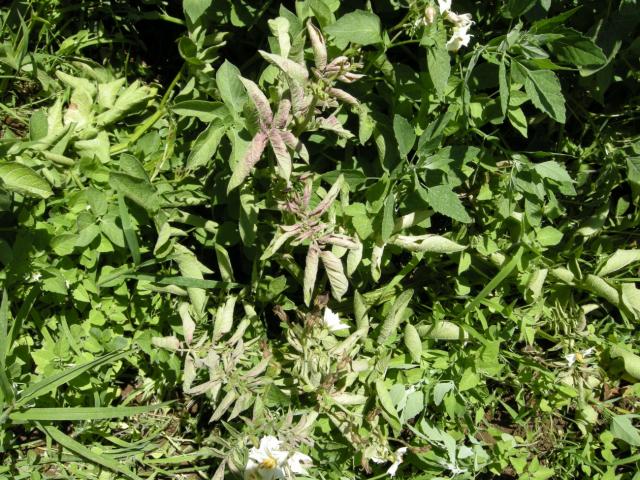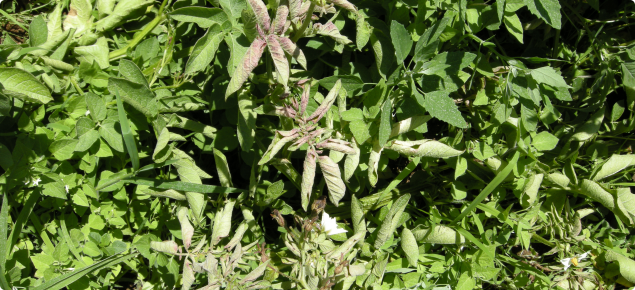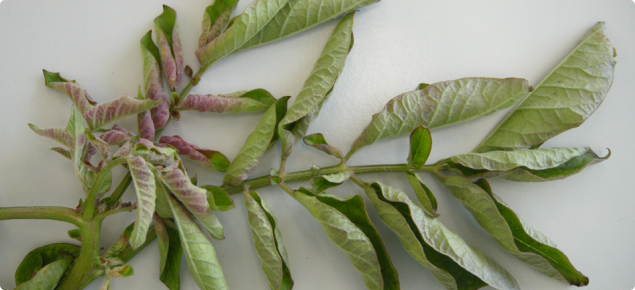Preferred scientific name
Candidatus Liberibacter solanacearum Liefting et al., 2009
Synonyms
Liberibacter psyllaurous
Liberibacter solanacearum
Candidatus Liberibacter psyllaurous Hansen et al., 2008
Preferred common name
Candidatus Liberibacter solanacearum bacteria are grouped into five gene groups or haplotypes. Each haplotype infects different vegetable crops, and is spread by different kinds of insects (psyllids).
Haplotypes A and B are sometimes referred to as CLso, and are the causal agent of Zebra chip in potatoes.
Haplotypes C, D and E are sometimes referred to as CaLsol.
Common host plants
Candidatus Liberibacter solanacearum haplotypes A and B infect solanaceous plants, including potato, tomato, capsicum, eggplant, tamatillo, tamarillo and several weed species (Munyaneza 2012).
Candidatus Liberibacter solanacearum haplotypes C, D and E infect apiaceous cplants, including carrot, celery, chervil, fennel and parsnip (Munyaneza et al. 2010) and (Teresani et al. 2014).
Plant part affected
Entire plant.
Australian distribution
In 2017, the Candidatus Liberibacter solanacearum haplotype D was detected in parsley seed imported from Italy (originating in France), and haplotype E was detected in parsley seed imported from Germany. See the Candidatus Liberibacter solanacearum declared pest page for current information on the detections.
However, no types of Candidatus Liberibacter solanacearum have been found in any Australian crops and the bacterium is not officially considered present in Australia.
Status in Western Australia
Candidatus Liberibacter solanacearum Liefting et al., 2009 is considered to be absent from Western Australia and is a quarantine pest. It is a prohibited organism under section 12 of the Biosecurity and Agriculture Management Act 2007.
To confirm the current status please check the Western Australian Organism List. For more information on prohibited organisms please see frequently asked questions about the BAM Act and WAOL.
Biology and ecology
Candidatus Liberibacter solanacearum is a phloem-limited and Gram-negative bacterium that is primarily spread from infected to healthy plants by psyllid insect vectors. The bacterium can also be transmitted by grafting (Secor et al. 2009). Although only limited experiments have been conducted, it appears true seed transmission of Candidatus Liberibacter solanacearum from infected solanaceous plants does not occur (Munyaneza 2012; CABI 2017).
Five haplotypes of Candidatus Liberibacter solanacearum have been described so far (Nelson et al. 2011; Nelson et al. 2013; Teresani et al. 2014). Two haplotypes (A and B) are associated with tomato-potato psyllid (Bactericera cockerelli) (Figure 1) and diseases in potatoes and other solanaceous plants, whereas the other three (C, D and E) are associated with diseased carrots and celery and Trioza apicalis and Bactericera trigonica, respectively.
The tomato-potato psyllid vector was detected in Western Australia in February 2017.
Symptoms in solanaceous plants
The following symptoms are an extract from CABI (2017).
Characteristic above-ground plant symptoms of Candidatus Liberibacter solanacearum infection in potato, tomato and other solanaceous species include stunting; erectness of new foliage; chlorosis and purpling of foliage, with basal cupping of leaves; upward rolling of leaves throughout the plant (Figure 2); shortened and thickened terminal internodes resulting in plant rosetting; enlarged nodes, axillary branches or aerial tubers; leaf scorching; disruption of fruit set, and the production of numerous, small, misshapen and poor quality fruits.

In potato, below-ground symptoms include collapsed stolons, browning of vascular tissue concomitant with necrotic flecking of internal tissues and streaking of the medullary ray tissues, all of which can affect the entire tuber (Figure 3). Upon frying, these symptoms become more pronounced and chips or fries processed from affected tubers show dark blotches, stripes or streaks, rendering them commercially unacceptable The symptoms in potato tubers have led to the disease being named ‘zebra chip’ (CABI 2017). Zebra chip symptoms might develop during storage (Munyaneza 2012).
Consumption of potatoes infected by zebra chip is not known to pose any risk to human health.
As Candidatus Liberibacter solanacearum is mainly transmitted by infected psyllids, management of the psyllid is currently believed to be the only means to effectively manage the disease (Munyaneza 2012).

Economic consequences
Candidatus Liberibacter solanacearum can cause severe damage to the yield and quality of its host crops (Soliman et al. 2013) and may kill the entire plant. Severe crop losses amounting to millions of dollars of damage have occurred in the United States, Mexico, Central America and New Zealand (Gudmestad & Secor 2007 cited in DEFRA 2014 P. 8). Large scale losses have also been reported in tomato production (Liefting et al. 2009).
In potato, plant growth is negatively affected and yield reduction has been estimated to be 25-40% (EPPO 2012). An epidemic of this disease may lead to whole crops being rejected. Chips or fries processed from zebra chip affected tubers exhibit dark stripes affecting their taste and making them commercially unacceptable (Munyaneza 2012).
Other solanaceous plants in the environment, including amenity plants may be affected by symptoms of Candidatus Liberibacter solanacearum infection. Infection may reduce the amenity value or even result in plant death.
What do I do if I find it?
Candidatus Liberibacter solanacearum Liefting et al., 2009 is a prohibited organism for Western Australia. It is important that any suspect disease occurrences are reported. Early detection and eradication will help protect the Western Australian potato and vegetable industries. Please contact the Pest and Disease Information Service on 9368 3080 or the Exotic Plant Pest Hotline on 1800 084 881 to report this pest.
More information
Refer to the NSW Department of Primary Industries website.
References
CABI 2017, Candidatus Liberibacter solanacearum (zebra chip) Crop Protection Compendium [online database]. CAB International (CABI), Wallingford, UK. <http://www.cabi.org/cpc/datasheet/109434> [February 2017].
DEFRA 2014, Rapid pest risk analysis for Candidatus Liberibacter solanacearum. Department for Environment, Food & Rural Affairs (DEFRA), London, UK.
EPPO 2012, Pest risk analysis for Candidatus Liberibacter solanacearum in Solanaceae. European and Mediterranean Plant Protection Organization (EPPO), Paris.
Liefting LW, Sutherland PW, Ward LI, Paice KL, Weir BS & Clover GR 2009, A new ‘Candidatus Liberibacter’species associated with diseases of solanaceous crops. Plant Disease, 93: 208-214.
Munyaneza J, Fisher T, Sengoda V, Garczynski S, Nissinen A & Lemmetty A 2010, First Report of "Candidatus Liberibacter solanacearum" associated with psyllid-affected carrots in Europe. Plant Disease, 94: 639.
Munyaneza JE 2012, Zebra chip disease of potato: Biology, epidemiology, and management. American Journal of Potato Research, 89: 329–350.
Nelson WR, Fisher TW & Munyaneza JE 2011, Haplotypes of “Candidatus Liberibacter solanacearum” suggest long-standing separation. European Journal of Plant Pathology, 130: 5–12.
Nelson WR, Sengoda VG, Alfaro-Fernandez AO, Font MI, Crosslin JM & Munyaneza JE 2013, A new haplotype of “Candidatus Liberibacter solanacearum” identified in the Mediterranean region. European Journal of Plant Pathology, 135: 633–639.
Secor GA, Rivera VV, Abad JA, Lee I-M, Clover GRG, Liefting LW, Li X & De Boer SH 2009, Association of ‘Candidatus Liberibacter solanacearum’ with zebra chip disease of potato established by graft and psyllid transmission, electron microscopy, and PCR. Plant Disease, 93: 574–583.
Soliman T, Mourits MCM, Oude Lansink AGJM & van der Werf W 2013, Economic justification for quarantine status – the case study of ‘Candidatus Liberibacter solanacearum’ in the European Union. Plant Pathology, 62: 1106–1113.
Teresani GR, Bertolini E, Alfaro-Fernández A, Martínez C, Tanaka FAO, Kitajima EW, Roselló M, Sanjuán S, Ferrándiz JC & López MM 2014, Association of ‘Candidatus Liberibacter solanacearum’ with a vegetative disorder of celery in Spain and development of a real-time PCR method for its detection. Phytopathology, 104: 804–811.






